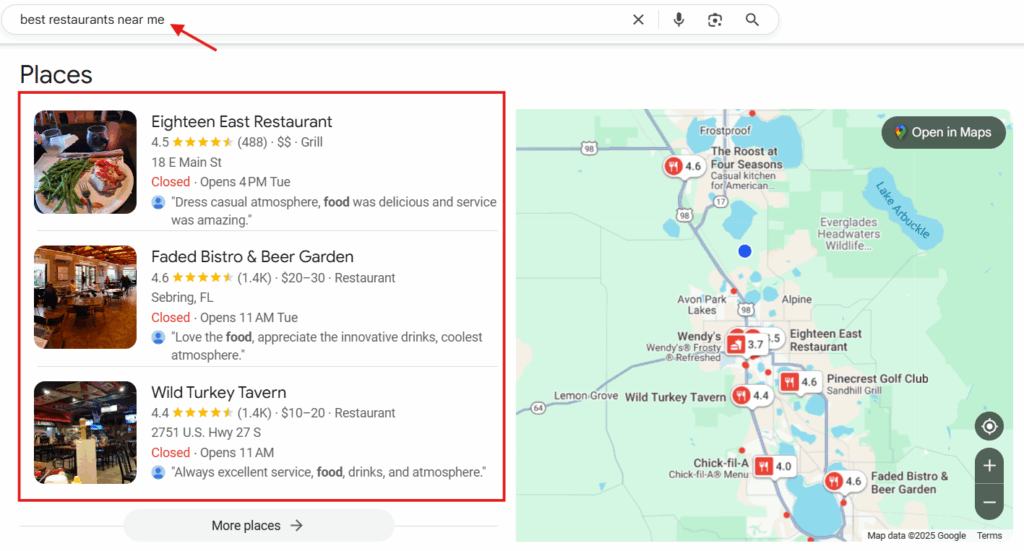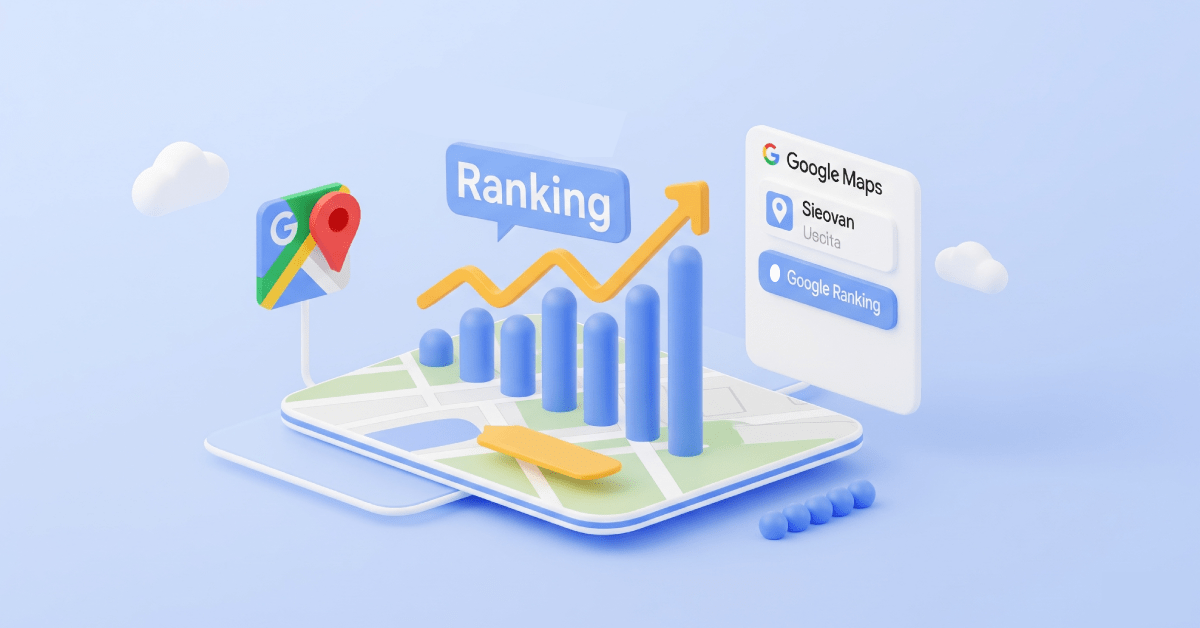Visibility on Google Maps can make or break a local business. I know because I have been advising local businesses on how to rank in Google Maps over the past few years.
When someone nearby searches for a service you offer, showing up at the top of Google Maps means more clicks, calls, and foot traffic through your door. In my experience as a marketer, local businesses that optimize for Google Maps SEO consistently outperform competitors in attracting in-person visits.
Nearly 46% of all Google searches have local intent. As you can see, people are actively looking for businesses near them. Improving your Google Maps ranking means that you’ll position your company to capture these high-intent customers.
In this guide, I’ll walk through an 8-step framework to boost your Google Maps ranking and dominate local search results.
Why Google Maps Rankings Matter
Appearing prominently on Google Maps directly drives business growth. 42% of local searches result in clicks on Google Map Pack, which shows how much traffic those top 3 map listings attract.

High visibility on Maps leads to tangible benefits: more driving direction requests, more calls (from the click-to-call button), and more walk-ins. Think about user behaviour – when someone searches “best pizza near me” on their phone, Google Maps shows a few top results with reviews, photos, and a map.
If your restaurant is in that pack, the user can tap for directions or call instantly. They will also see your star rating, reviews, and hours of operation, which heavily influence their decision.
From my experience, businesses that rank in the top Map results see a noticeable uptick in new customers who discovered them via Maps. Simply put, local visibility equals local customers. There are many other benefits of local SEO as well, but ranking on Google Maps is one of the most impactful for offline conversions.
Understanding How Google Maps Rankings Work
Before we discuss the tactics, it helps to know how Google decides who ranks higher on Maps. Google’s local algorithm revolves around three core factors: Relevance, Distance, and Prominence.
Google combines these factors to serve the best match for each local search. For example, if you run “Joe’s Pizza” in Atlanta and someone nearby searches for “best pizza Atlanta,” Google will consider how relevant your profile is. Are you categorized as a pizza restaurant? Do you mention “best pizza” in reviews or descriptions? How close are you to the searcher’s location, and how prominent are you?
Relevance
How well does your business profile match what someone is searching for? This is why optimizing your listing with the right categories, keywords, and details is crucial. It tells Google what your business is and who should see it.
If someone searches for “24-hour pharmacy,” Google won’t show a pharmacy that closes at 9 pm because it is not relevant to that query. Providing complete and detailed business info helps Google understand your offerings.
Distance (Proximity)
A business that is physically nearer to the searcher is more likely to appear. This is often out of your control (you can’t move your store for SEO!). But it means that including your address and service areas accurately is essential. Google will factor in distance if the user doesn’t specify a location.
For instance, showing the closest coffee shops when someone simply searches “coffee shop” on Maps.
Prominence
How well-known and reputable is your business, both online and offline? This factor includes things like review count and ratings, your business’s online mentions (citations), and even inbound links to your website. Essentially, Google tries to gauge if your business is popular and trustworthy.
A business with hundreds of positive reviews, lots of news articles or directory listings, and a strong web presence will have high prominence. More reviews and positive ratings can boost your local ranking. Offline prominence (a famous landmark or well-known local brand) can play a role too.
Our goal is to optimize all the factors we can influence – especially relevance and prominence – so that your business becomes the top match. Remember, you cannot pay Google to rank higher in Maps, so these optimizations are the only path to better visibility.
8 Steps on How to Rank in Google Maps
Now let’s get into the practical steps. Follow these 8 actionable strategies to improve your Google Maps rankings. Each step is based on proven local SEO techniques that I have used to help businesses get into the coveted “3-pack” map results.
Step 1: Claim and Verify Your Google Business Profile

You must have a Google Business Profile (GBP) that is claimed and verified. If you haven’t done this, go to the Google Business Profile page and follow the prompts to “Add your business” on Google.
Claiming your profile ensures you have control over the information displayed on Google Maps and Search.
Google may verify your business by mail (sending a postcard with a code), phone, or email. Follow their instructions and complete the verification as fast as possible – this step is critical. In my experience, getting that verification postcard and entering the code promptly can shave days off your profile going live.
Once verified, you’ll see a badge on your profile indicating it is owner-verified. This also gives you a slight trust boost in Google’s eyes and a “Verified” status that users can see.
Don’t stop at verification. Fill out every section of your Google Business Profile dashboard. Provide:
- Business Name – exactly as your real-world name, no extra keywords or LLC text
- Address – ensure it’s precise and matches what’s on your website/contact page
- Phone Number – use a local number if possible, not just a call centre or 800 number
- Business Hours – include regular hours and special holiday hours
- Website URL
- Primary and secondary categories
- Attributes – e.g., “Wheelchair accessible,” “Free Wi-Fi,” depending on your business type
- Description – a 750-character blurb about your business
A complete profile not only helps customers but also improves your relevance for search. Google has stated that businesses with complete and accurate information are more likely to be shown in local results.
Step 2: Optimize NAP Consistency (Name, Address, Phone)
For Google to trust your listing, you must optimize your NAP to be consistent everywhere online. That means the way your business name, address, and phone appear on your Google profile should exactly match how they appear on your website and other directories. Inconsistent NAP information can confuse Google (and customers) and, in turn, hurt your rankings.
Start by auditing your own website’s contact page and footer – does the business name and address match your Google listing character for character? Every listing should have the same spelling, formatting, and phone number. This includes using or not using suite numbers and parentheses in phone numbers consistently.
Remember, trying to game the system with fake addresses will likely get your listing suspended or ranking suppressed.
Step 3: Select the Right Business Categories
Choosing the proper categories for your Google Business Profile is a high-impact decision. Google allows you to select one primary category and several secondary categories to describe your business. These categories influence which searches you’ll be considered relevant for. They are essentially Google’s way of classifying your business.
Use a primary category that best matches your leading service. Be specific – if you are a personal injury lawyer, use “Personal Injury Attorney” rather than a generic “Lawyer” category. The primary category is weighted heavily by Google for relevance. It should reflect your core offering or the category your business is most known for.
You can add secondary categories to cover other services or products you offer. For instance, a primary category might be “Salon,” and secondary categories could be “Hair Salon,” “Nail Salon,” “Spa” if you offer all those services. Look at what your top competitors are using for categories – this can give clues.
Don’t overload with too many categories in an attempt to show up for everything. Stick to truly relevant ones. Category spam can dilute Google’s understanding of your business.
Step 4: Add High-Quality Photos (and Make Regular Posts)

Visuals matter – both to customers and to Google. Business listings with well-lit and clear photos are simply more engaging and appear more credible. Google knows this and often showcases photos in the Maps interface (e.g., the photo carousel at the top of a business profile).
According to Google, listings with photos get significantly more click-throughs and requests for directions than those without.
Here is a breakdown of the photos you need:
- Exterior photos: Show what your storefront or building looks like from the outside. This helps people recognize it when they approach (and assures them it actually exists!). Take a couple from the street and from different angles.
- Interior photos: Give a sense of the atmosphere. If you run a restaurant, show the dining area. If you have a retail shop, show the inside layout. People love “peeking inside” before they visit.
- Product or service photos: If you’re a restaurant, post drool-worthy shots of your best dishes. If you’re a salon, show hairstyles or nail art.
- Team photos: Adding a human touch can set you apart. A smiling team photo or pictures of the owner engaging with customers personalize your business.
- Before/after or project photos: For service businesses (contractors, landscapers, auto detailing, etc.), before-and-after pictures of your work can highlight quality.
Step 5: Gather and Respond to Reviews
Reviews are the backbone of local SEO. They influence ranking and heavily influence customer behavior. Google’s algorithm considers both the quantity and quality of reviews as a signal of prominence and trustworthiness.
For users, seeing a solid star rating and recent positive comments can be the deciding factor in choosing your business over another. So, how do you get more Google reviews (and handle them effectively)?
- Ask, ask, ask: Most happy customers won’t think to leave a review unless prompted. Develop a system to regularly request reviews from your customers. The key is to ask at the right moment – typically soon after a successful sale or service, when the customer’s satisfaction is high.
- Use tools to simplify review collection: If manually asking each time is tough, leverage technology. There are platforms (including Krofile) that can streamline this. Krofile, for instance, allows businesses to generate a QR code or NFC tag that directly opens the Google review page.

- Incentives vs. policy: Be careful not to offer improper incentives for reviews. It is against Google’s policy (and many laws) to pay or reward people for positive reviews. Focus on earning reviews organically by delivering outstanding service and then making it easy for happy customers to share their experience.
- Respond to every review – good or bad: Google explicitly encourages owners to reply to reviews, and doing so can improve your local SEO a bit (prominence/engagement signal) and definitely improves your public image.
Step 6: Use Local Keywords in Your Business Description

While the business description in your Google profile isn’t a heavy ranking factor, it is still a place to naturally include some keywords about your services and location. Think of it as an opportunity to tell both customers and Google what you do, where you do it, and what makes you special.
You should also optimize your description with local keywords. This doesn’t mean keyword stuffing (don’t just list every city and service). But you should mention your primary product/service and the area you serve in a readable way.
Step 7: Leverage Local Citations and Directories
Citations are online mentions of your business’s NAP details on other websites – essentially, directory listings. Building and managing citations is a cornerstone of local SEO. The more high-quality, consistent citations you have, the more Google sees your business as established and legitimate in the local community.
Think of citations as the local SEO equivalent of backlinks – they are trust votes from around the web that confirm your business information. Ensure you are listed (with correct NAP) on major platforms like:
- Yelp
- Facebook Business (your Facebook Page counts as a citation)
- Apple Maps (via Apple Business Connect)
- Bing Places (Bing’s equivalent of Google Business)
- Yellow Pages (YP.com)
- TripAdvisor (if relevant, e.g., hospitality, attractions)
- Better Business Bureau, etc.
Step 8: Encourage Check-ins and Engagement
Google likely monitors actions like clicks for directions, clicks to call, website clicks from the profile, and even check-ins or photos uploaded by users at your location. These behaviors can influence ranking over time because they indicate real-world popularity.
Here is how to boost engagement on your Google Maps listing:
- Encourage customers to use the “Check-in” feature or add photos: For example, a popular tactic for restaurants and cafes is to create an Instagrammable spot or encourage patrons to take pictures and upload them.
- Leverage Google’s Q&A section: The Q&A on your Business Profile allows the public to ask questions and get answers. You can actually seed this yourself by posing common questions (from another account) and answering them. This is both good for users (FAQ right on your listing) and adds more content/keywords to your profile.
- Use Google’s booking or messaging features if applicable: If you are in an industry that supports booking through Google (like salons, restaurants via OpenTable, etc.), enable that. Or if available, turn on the Messaging feature so users can message you from the listing.
- Monitor Google Maps “Insights”: In your GBP dashboard, the Insights section shows data like how many people requested directions, called you, etc.
Krofile also allows you to monitor engagement levels and visitor activity from the main dashboard.

3 Advanced Google Maps SEO Tips
If you have implemented the steps above, you have covered the essentials of Google Maps ranking. Now let’s explore a few advanced tactics to squeeze out every advantage and future-proof your local SEO strategy.
Geo-tagged Images: Do They Matter?
Geo-tagging images means embedding the latitude and longitude (and other location data) into the image’s metadata (EXIF data). The idea was that if you upload photos to your Google profile that have your business’s coordinates, Google might associate your business strongly with that location and boost your ranking for local queries.
However, evidence suggests that Google strips out geo EXIF data from images upon upload to Google Business.
Website SEO and Schema Markup for Local
Your website and Google Business Profile are closely linked in Google’s eyes. A well-optimized website can boost your Maps ranking too (that “Prominence” factor includes your website’s SEO authority).
Here are some advanced on-site tactics:
- Embed your Google Map on your contact page
- Use LocalBusiness Schema Markup
- Create location-specific landing pages
- Backlinks for local SEO
- Optimize for “Near Me” searches
- Fast and mobile-friendly site
Embedding Google Maps on Your Website
When you embed the Google Map of your business location on your website, a few things happen:
- Visitors on your site can easily see your location and click for directions.
- You are essentially linking your site to your Google listing.
- It subconsciously tells users that, “this business is real – it exists at this spot.”
From an SEO perspective, while embedding a map alone won’t shoot you to #1, it is one more optimization that, combined with others, creates an overall stronger local presence.
7 Common Mistakes You Must Avoid
Even seasoned businesses can slip up on local SEO. Avoid these common mistakes that can sabotage your Google Maps rankings or even get your listing penalized:
- Using Virtual Offices or P.O. Boxes as Addresses: As mentioned, Google explicitly forbids listing an address that isn’t a real physical presence for your business.
- Keyword-Stuffing Your Business Name: This is against the guidelines, and competitors can report you. You risk suspension or a tough rebranding of your profile later.
- Duplicate Listings: Having more than one Google Business Profile for the same business location is counterproductive. Google might filter them out or even suspend one or both if it appears manipulative.
- Spammy Tactics for Reviews: Buying reviews, as discussed, is not only unethical but risky. Earn reviews honestly. And of course, never post fake negative reviews on competitors – that can backfire and also is just bad form (and possibly illegal in some regions as defamation).
- Neglecting Your Profile: Some businesses claim their profile, do the basics, and then forget about it. Meanwhile, customers might be asking questions in the Q&A, or new reviews come in that go unanswered. Lack of responsiveness can harm your reputation and ranking.
- Wrong Category or Missing Categories: Sometimes out of haste, businesses choose a poorly fitting category or forget to update it when their focus changes. Using the wrong primary category can essentially make your profile invisible for the terms you care about (you’ll show up for the wrong searches). Review your categories periodically to ensure they still align with your services. Google also adds new categories – if a new one describes you better, switch to it or add it.
- Overlooking the Importance of Website Quality: A business with a functional, informative website linked to its profile will generally outrank one with no website or a poor site, all else being equal.
Tracking Your Google Maps Ranking Progress
Once you have put in all this work to optimize your Google Maps presence, you’ll want to measure the results. Tracking your progress helps you see what is working, what is not, and where to adjust your strategy.
Start with the built-in metrics Google provides. In your GBP dashboard (or the Google Maps app if you use that to manage), you’ll find Insights showing:
- How many people viewed your profile
- What actions did they take (calls, direction requests, website clicks)
- The number of photo views (yours vs customers’ photos)
- Queries used to find your business (this is gold – it lists some of the search terms people used)
Keep an eye especially on direction requests and calls – those are strong indicators of real-world engagement (and likely sales). If those are rising month over month, your optimization is paying off.
GBP Insights won’t explicitly tell you “you moved from rank 5 to rank 3,” but if you see steady growth in impressions and actions, that likely correlates with better visibility.
Remember that the goal isn’t just ranking, but more customers. If you have call tracking numbers or a CRM, see if leads increased. If foot traffic is a goal, maybe use a simple question like “How did you hear about us?” at checkout to see if more people say “Found you on Google Maps.”
You can also track clicks on driving direction buttons via Google Analytics if you embed a map or use the Google Maps API on your site.








